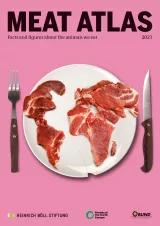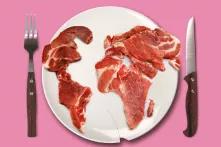
The meat industry used to be famous for using “everything about the hog except the squeal”. But a large proportion of the
livestock raised for food do not end up as food. Many die, or are killed, before they reach the slaughterhouse, and even more meat is wasted between the factory and the plate.

At the start of the 1990s, Europeans were shocked to see photos of hundreds of thousands of dead cattle. Yet BSE, or “mad cow” disease, was not the last disease outbreak to result in the culling and disposal of large numbers of animals that had been intended for human consumption. After BSE came bird flu, and after that, African swine fever. Experts estimate that this last disease, which is highly contagious in pigs, resulted in the deaths of up to 200 million pigs in China, either directly or culled as a precaution.
Even without such disease outbreaks, many animals die before they can be taken to the abattoir. In France alone, more than 200 million animals are killed every year without being used as meat. These include animals that die while they are being reared, or that are culled and disposed of for economic reasons. In Germany, up to 200,000 male dairy calves and 45 million male chicks of layer breeds die because they would produce too little meat, so are not worth keeping alive for fattening. In France, over 50 million male chicks are killed each year directly after they hatch.
On the other hand, performance-oriented breeding and poor husbandry conditions lead to animals dying during the rearing stage. Denmark, a much smaller country than Germany, Spain and France, has the fourth highest pig population in Europe. The average litter size for pigs has risen in recent years to 19.4 piglets per sow – five more within just one decade. The problem is that the average sow has only 14 or 15 functioning teats. As a result, the piglets are smaller and more delicate, and many die at birth or within the first few days of life. The mortality of suckling piglets in Denmark is around 15 percent, or about 3 million dead animals a year. In all, 28 percent of animals die at various stages of pregnancy, rearing and fattening.
In Germany, the average litter size is just above 15. Still, around 16 percent of all suckling piglets die. Because of Germany’s higher pig population, that adds up to 8.6 million dead piglets a year.
A lot of loss occurs after slaughter too, as by no means do all parts of the animal end up on dinner plates. Because meat has become relatively cheap, consumers in many countries have become choosy: they eat only certain cuts. Along with Romania, Poland has the lowest meat prices in the European Union. The average Polish consumer ate 77.1 kilograms of meat and offal in 2019, a rise of 9 percent over 2005. But the consumption of fat and offal fell by 9 percent in the same period. Even if these animal parts are not thrown away but are used in industry, they are no longer food.
Poultry is becoming more and more popular. Per capita Polish consumption in 2019 was 28.3 kilograms, some 21 percent higher than in 2005. Meanwhile, Poland has become the largest poultry producer in Europe. EU citizens prefer chicken breasts; other parts, such as wings and drumsticks, are often frozen and exported to Asia and Africa.
Only 60 percent of a slaughtered pig in Germany ends up as cutlets or sausage on a plate. The parts not suited for human consumption, such as bones, hooves and some internal organs, are rendered into food for pets or fish, used in the chemical or fertilizer industry, or turned into biofuel. Out of the 8.6 million tonnes of total slaughter weight in 2019, around 2.6 million tonnes of such “animal by-products” were used in these ways. Further losses occur during wholesale and retail trade, as well as at the consumption stage, as items pass their sell-by dates or food is prepared for consumption but not actually eaten. In 2016, the most recent data available, 11.9 percent of global meat production was lost between slaughter and retail.
That amounts to 39 million tonnes, or the equivalent of 115 million cattle or 413 million pigs. Such high losses represent an enormous waste of resources, as these animals had to be reared and fed, even though they never ended up as human food. While inadequate refrigeration is the main problem in the global South in the developed world the disposal of food that is fit for consumption is mainly to blame. Studies estimate that this accounts for between 4 and 11 percent of the quantity actually consumed in Europe. This is also because meat, with its comparatively cheap prices, is becoming less and less valued as a type of food.
Losses and waste can be reduced at each stage in the value chain. In the developing world, better veterinary care and refrigeration would help. In the developed world, livestock farmers can adopt husbandry methods that avoid high losses, along with more robust breeds and, in pigs, smaller litters. Multipurpose breeds of cattle and chickens would avoid the economic pressure to kill males. An increasing volume of somewhat dearer eggs from dual-purpose hens is now coming on the market. These breeds lay fewer eggs, but the males also produce meat. From 2022 on, shredding day-old chicks will be banned in France. Germany and Spain have gone a step further, deciding to ban the killing of day-old chicks.
The waste of food can be avoided primarily through a greater appreciation of its worth. Consumers could, for example, reflect on the need to use the whole animal, as used to be the case. Instead of always opting for steak or chicken breast on the menu, they might occasionally choose a less popular type of meat or offal. That would also be a gain for culinary diversity.


